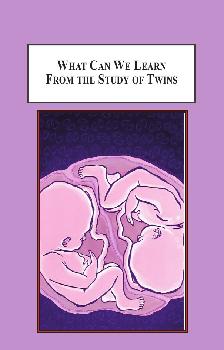This is our backup site. Click here to visit our main site at MellenPress.com
What Can We Learn From the Study of Twins? An Evaluation of the Equal Environments Assumption

| Author: | Felson, Jacob | |
| Year: | 2012 | |
| Pages: | 160 | |
| ISBN: | 0-7734-2907-7 978-0-7734-2907-9 | |
| Price: | $139.95 | |
Most evidence about genetic behavior comes from twin studies. The presumption is that this enables an equal environment assumption (EEA). This book argues that the validity of the EEA argument is not as strong as some behavior geneticists have claimed. Felson conducts the most comprehensive evaluation of the EEA to date. His analysis incorporates a larger more diverse set of outcome variables than any previous research on the subject.
Reviews
“This study is very thorough and methodologically sound. It reveals that although many researchers argue that the support for an equal environments assumption is extensive, the findings are not always clear-cut.”
-Prof. Alan Booth,
Penn State University
“Felson’s manuscript is extremely well done and timely. His writing is clear, his analysis sophisticated and appropriate.”
-Prof. Kevin Beaver,
Florida State University
“Behavior Genetics, rather than being a discipline, is a set of techniques. These techniques should be as much a part of Sociology as survival analysis and spatial demography. Felson’s work is an important step toward making this happen.”
-Prof. Hobart H. Cleveland,
Penn State University
-Prof. Alan Booth,
Penn State University
“Felson’s manuscript is extremely well done and timely. His writing is clear, his analysis sophisticated and appropriate.”
-Prof. Kevin Beaver,
Florida State University
“Behavior Genetics, rather than being a discipline, is a set of techniques. These techniques should be as much a part of Sociology as survival analysis and spatial demography. Felson’s work is an important step toward making this happen.”
-Prof. Hobart H. Cleveland,
Penn State University
Table of Contents
Abstract
Foreword by Alan Booth
Acknowledgements
1. Introduction
1.1 Plan for the Book
1.2. Estimating the effects of genes on variation in traits with twin studies
1.3 Estimating heritability
1.4 Evaluating the twin study as a natural experiment
2. Literature Review
2.1 Earliest studies (1930-1960)
2.1.1 Review and analysis of Wilson (1934)
2.1.2 Early study comparing MZ and DZ twins by Mowrer (1954)
2.1.3 Other studies conducted prior to 1960
2.2 Early Studies (1965-1979)
2.2.1 Scarr (1968)
2.2.2 Matheney et al. (1976)
2.2.3 Landmark twin study of Loehlin and Nichols (1976)
2.2.4 Lytton (1977)
2.2.5 Scarr and Carter-Saltzman (1979)
2.3 Recent studies
2.4 Studies of adopted children and studies of twins reared apart
3. Data
3.1 Measures
3.1.1 Outcome measures
3.1.2 Measures of environmental similarity
3.1.3 Measure of zygosity
3.1.4 Other control variables
3.2 Handling missing data
4. Methods
4.1 Comparisons of means and variances by zygosity
4.2 Examining measures of environmental similarity
4.3 Absolute value regressions
4.4 Defries-Fulker regressions
4.5 Propensity score matching
4.6 Why propensity score matching?
5. Results
5.1 Comparisons of means and variances by zygosity
5.2 Examining measures of environmental similarity
5.3 Absolute value regressions
5.4 Defries-Fulker regressions
5.5 Propensity score matching
5.6 Effects of matching on estimates of heritability
6. Conclusion
References
Index
Foreword by Alan Booth
Acknowledgements
1. Introduction
1.1 Plan for the Book
1.2. Estimating the effects of genes on variation in traits with twin studies
1.3 Estimating heritability
1.4 Evaluating the twin study as a natural experiment
2. Literature Review
2.1 Earliest studies (1930-1960)
2.1.1 Review and analysis of Wilson (1934)
2.1.2 Early study comparing MZ and DZ twins by Mowrer (1954)
2.1.3 Other studies conducted prior to 1960
2.2 Early Studies (1965-1979)
2.2.1 Scarr (1968)
2.2.2 Matheney et al. (1976)
2.2.3 Landmark twin study of Loehlin and Nichols (1976)
2.2.4 Lytton (1977)
2.2.5 Scarr and Carter-Saltzman (1979)
2.3 Recent studies
2.4 Studies of adopted children and studies of twins reared apart
3. Data
3.1 Measures
3.1.1 Outcome measures
3.1.2 Measures of environmental similarity
3.1.3 Measure of zygosity
3.1.4 Other control variables
3.2 Handling missing data
4. Methods
4.1 Comparisons of means and variances by zygosity
4.2 Examining measures of environmental similarity
4.3 Absolute value regressions
4.4 Defries-Fulker regressions
4.5 Propensity score matching
4.6 Why propensity score matching?
5. Results
5.1 Comparisons of means and variances by zygosity
5.2 Examining measures of environmental similarity
5.3 Absolute value regressions
5.4 Defries-Fulker regressions
5.5 Propensity score matching
5.6 Effects of matching on estimates of heritability
6. Conclusion
References
Index
